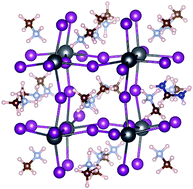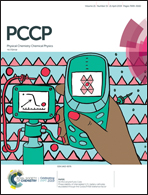Effect of organic cation states on electronic properties of mixed organic–inorganic halide perovskite clusters
Abstract
We study the effect of organic cation-centered states in mixed organic–inorganic halide perovskites on the bandstructure and optical properties. Clusters of methylammonium lead iodide (MAPbI3) and bromide (MAPbBr3) and of MAPbI3 (MAPbBr3) in which an organic cation was substituted with formamidinium (FA) and guanidinium (GA) are studied with density functional theory and time-dependent density functional theory. This model permitted comparing bandstructure and optical properties with different organic cations computed with GGA and hybrid functionals. We find that while with MA and GA, cation-centered states are deep in the conduction band, with FA, organic cation-centered states are introduced within as little as 0.5 eV of the conduction band maximum, which are expected to influence electronic and optical properties of perovskites in solar cells and other optoelectronic devices. There is qualitative agreement between a GGA and a hybrid functional; however, the use of a hybrid functional leads to a slightly higher offset of the cation-centered states from the conduction band edge, a different order of electronic states, and much better localization of cation-centered states. Analysis of optical absorption spectra suggests that occupation by photoexcitation of FA-centered states and formation of transient formamidinium species is possible in both I and Br-based perovskites.



 Please wait while we load your content...
Please wait while we load your content...